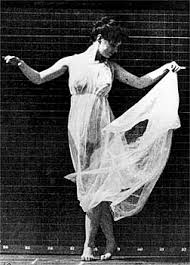Today, another bookish post from the awesome Allison McCarthy! Enjoy. -Deborah

My knowledge of Isadora Duncan was previously limited to what I had learned in college, which is to say that I recalled a few vague details delivered in a 200-level dance/theater course. Although there were no assigned textbooks in that class, I probably would have loved a class discussion on Sabrina Jones’ new graphic novel, Isadora Duncan: A Graphic Biography. At the very least, I’d have paid more attention.
Jones covers both the major milestones and the smaller details of Duncan’s life, career and love affairs. From an early age, Duncan explicitly rejected traditional forms of dance like ballet in search of a looser, more natural technique based on, of all things, her study of how the ocean crests and waves. Known by admirers as “the barefoot dancer,†Duncan is famous for her groundbreaking performances and free-spirited approach to touring; she danced in Soviet Russia, as well as all over the U.S. and Europe, eventually founding multiple schools for young women to learn her methods. Throughout the book’s 125 pages, Jones effectively captures Duncan’s fanciful dance movements with precise, dazzling black-and-white illustrations.
Although Duncan never explicitly identified as a feminist, it’s clear that Jones views her as one: in the typical shorthand style of graphic artists, she recounts Duncan’s financial savvy, high level of education and her independence of thought, including her forays with the male intellectual elites of her time (F. Scott Fitzgerald, François-Auguste-René Rodin, and Abraham Walkowitz are among the most distinguished in her circle of friends). Her detractors labeled her as a “Bolshevik hussy,†yet Duncan never once censored her art, opting instead to find new venues and audiences who would embrace her challenging works. Entangled in several passionate affairs, Duncan ignored the nay-saying of her family and actively pursued younger men, older men, and other heterosexual relationships that were often seen as controversial in the early twentieth century. Equally unconcerned with her society’s imposed duality of being a dancer and mother, Duncan was both, even in the face of enormous tragedy that includes the death of her two children in a tragic accident and the stillbirth of her third child.
The reading level of the book says ages 9-12, so older readers may breeze through the bold illustrations more quickly than the intended audience will. This may also explain the tepid nature of the novel’s love scenes. Unlike 2007’s Dangerous Woman: The Graphic Biography of Emma Goldman by Sharon Rudahl, Jones includes no nudity or adult language, which leaves some scenes with a softened, YA-romance feel rather than a mature rendering of Duncan’s oft-discussed sexuality. Overall, however, this book presents a fascinating account of Isadora Duncan’s life and earns a strong position in the growing canon of literary graphic novels.
–Allison McCarthy

 Those of you who know me know that
Those of you who know me know that  I’ve seen books that teach you how to apply lessons from private life to leadership in the office, but this one takes leadership skills from the office and applies them to the home. The whole premise of Jamie Woolf’s
I’ve seen books that teach you how to apply lessons from private life to leadership in the office, but this one takes leadership skills from the office and applies them to the home. The whole premise of Jamie Woolf’s  As everyone’s sluggishly getting back into their groove, we at GWP wanted to thank our loyal readers for being part of the growing community over here and welcome our newer ones. We look forward to a new year with a new president in DC, insightful feminist critique in the blogosphere, and the continued contributions from our readers to the GWP experiment!
As everyone’s sluggishly getting back into their groove, we at GWP wanted to thank our loyal readers for being part of the growing community over here and welcome our newer ones. We look forward to a new year with a new president in DC, insightful feminist critique in the blogosphere, and the continued contributions from our readers to the GWP experiment! It happens every time this year. The pile of books that publishers have sent me unsolicited in the hopes for a review stares me in the face, creating a sense of guilt. Though I know that all publicists send books out widely as part of their general marketing strategy, I always feel, well, bad if we don’t end up reviewing a book that nevertheless looks fantastic. The book just sits on my shelf.
It happens every time this year. The pile of books that publishers have sent me unsolicited in the hopes for a review stares me in the face, creating a sense of guilt. Though I know that all publicists send books out widely as part of their general marketing strategy, I always feel, well, bad if we don’t end up reviewing a book that nevertheless looks fantastic. The book just sits on my shelf.
 This here’s an open call for reviews of the following, to be published here on GWP:
This here’s an open call for reviews of the following, to be published here on GWP: Just a quick hit today on a book I’m about to get my hands on, titled
Just a quick hit today on a book I’m about to get my hands on, titled 

